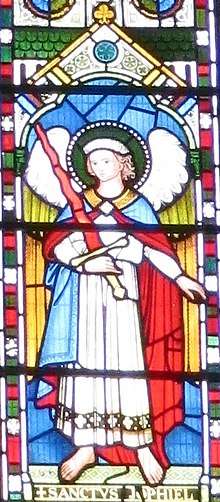Flaming sword (mythology)
A flaming sword is a sword glowing with flame by some supernatural power. Flaming swords have existed in legend and myth for thousands of years.
.jpg)
In Sumerian mythology, the deity known as Asaruludu is "the wielder of the flaming sword" who "ensures the most perfect safety".
According to the Bible, a cherub (or, in some traditions, either the archangel Uriel or Camael) with a flaming sword was placed by God at the gates of Paradise after Adam and Eve were banished from it (Genesis 3:24).
Eastern Orthodox tradition says that after Jesus was crucified and resurrected, the flaming sword was removed from the Garden of Eden, making it possible for humanity to re-enter Paradise.[3]
In Welsh mythology the Dyrnwyn ("White-Hilt") is said to be a powerful sword belonging to Rhydderch Hael,[4] one of the Three Generous Men of Britain mentioned in the Welsh Triads. When drawn by a worthy or well-born man, the entire blade would blaze with fire. Rhydderch was never reluctant to hand the weapon to anyone, hence his nickname Hael "the Generous", but the recipients, as soon as they had learned of its peculiar properties, always rejected the sword. Its fire would burn the man who drew it for an unworthy purpose.[5]
The sword wielded by Surtr, a jotunn of Muspelheim, is a flaming sword with immense destructive power that appears in Norse mythology.[6]
The sword which Acala holds may or may not be flaming and sometimes described only generically as a treasure sword (宝剣, hōken) or as vajra-sword (金剛杵, kongō-ken), which is descriptive of the fact that the pommel of the sword is in the shape of the talon-like vajra (金剛杵, kongō-sho) of one type or another.
Dumah is an angel mentioned in Rabbinical literature. Dumah is a popular figure in Yiddish folklore. I. B. Singer's Short Friday (1964), a collection of stories, mentions Dumah as a "thousand-eyed angel of death, armed with a flaming sword".
See also
References
- Lawrence, Robert M. (1898), The Magic of the Horse-Shoe, With Other Folk-Lore Notes, Chapter III: The Number Seven at sacred-texts.com
- Davidson, Gustav (1967), A Dictionary of Angels, Including The Fallen Angels, Entry: Iofiel, Free Press, p. 150, Library of Congress Catalog Card Number: 66-19757, ISBN 9780029070505
- Orthodox liturgy of the third Sunday of Lent
- Tri Thlws ar Ddeg, ed. and tr. Bromwich (1978): pp. 240–241.
- Rogers, Mark (2014-04-18). The Esoteric Codex: Magic Objects I. ISBN 9781312114562.
- Faulkes (1995:9–10)

